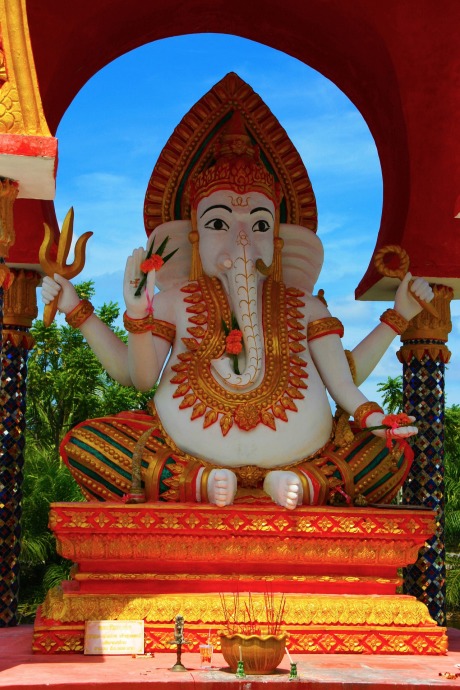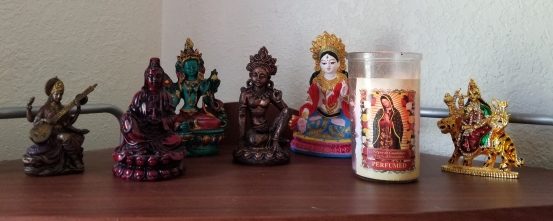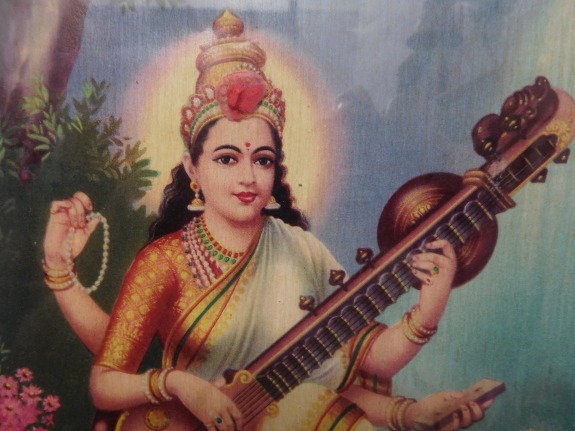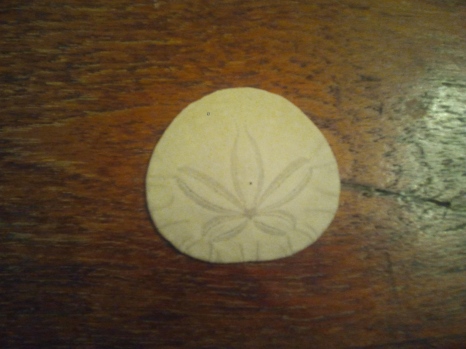I have been rather quiet on my various blogs recently. This has been a rather busy time for me. During the month of May, I took a course at Kepler College called Crash Course in Indian Astrology, which was taught by Kenneth Miller. The course proper is finished, but I still need to finish the final homework assignment.
I had wanted to study at Kepler College when it was still able to offer Master’s degrees, but at the time, it was not possible for me. I have also been curious about Indian Astrology for a long time. Unlike Western Astrology, Indian Astrology has a living tradition, so it did not seem fitting to attempt to learn it through self-study. It just so happened that I learned about this course at the same time that we got a nice-sized income tax refund, so I decided to go for it.
At the time, I had no intention of “converting” to Indian Astrology. I was only seeking to learn a little more about it so that I could talk intelligently when asked about the subject by friends or clients. A “crash course” seemed perfect for that purpose. Now that I am in the home stretch, I find that I am re-thinking the entire direction of my practice. Before I discuss this, however, I want to talk a little about the differences between Indian and Western Astrology.

Differences between Indian and Western Astrology
Indian Astrology, or Jyotish, is a different astrological language from Western astrology. It is a related language. Much of the vocabulary is recognizable, but it is used in different ways. Below are some of the main differences that I have learned so far.
Sidereal Zodiac(s)
Even beginning astrology students usually know that most practitioners of Western Astrology use the Tropical Zodiac, which is based on the Solstices and the Equinoxes. When learning this, students also learn that Indian Astrology uses “the” Sidereal Zodiac which is based on the constellations.
As it turns out, this is not really accurate. To begin with, none of the Sidereal Zodiacs in use by practitioners of Indian Astrology truly correspond to the actual constellations. For one thing, the constellations are not all the same size. The largest constellation, Virgo, is about 3 times the size of the smallest constellation, Capricorn. Just like the Tropical Zodiac, the Sidereal Zodiacs divide the ecliptic into 12 equal parts.
The difference is merely in where 0° Aries begins. In the Tropical Zodiac, 0° Aries begins at the Spring Equinox. In theory, the Sidereal Zodiacs begin at the first star of the constellation Aries in the sky. There is a problem, however. There is no bright star at the beginning of Aries to measure by.
As a result, various calculations of what is known as the Ayanamsa exist. The Ayanamsa is the difference between 0° Aries and the Spring Equinox. Apparently, historically, different almanacs were published in different villages with different Ayanamsas, most of which were calculated using one of the bright stars at the end of the constellation Pisces.
This became a problem not just for astrologers. In India, the dates of most of the major festivals are based on the position of the stars. The different Ayanamsas meant that different villages were celebrating their festivals at different times. To remedy the chaos that this could cause, in the 1950s, the Indian government standardized the Ayanamsa using modern scientific methods. This became known as the Lahiri Ayanamsa.
This did not settle the issue for astrologers, however. Apparently, rather than using stars at the beginning of Aries or the end of Pisces, Lahiri uses Spica, which is at the end of the constellation Virgo, and sets 0° Aries opposite to this fixed star. There is no traditional authority that allows the Ayanamsa to be calculated in this way, so there are quite a few astrologers who reject this calculation.
All in all, it seems like the calculation of the Ayanamsa in Indian Astrology is as chaotic as the quadrant House divisions are in Western, if not more so.
Other Technical Differences
Speaking of House divisions, practitioners of Indian Astrology, by and large, use the Whole Sign House system. This goes a long way in reducing the amount of chaos that the different Ayanamsas would otherwise cause.
This brings me to a different issue. Even though most practitioners of Western Astrology use the Tropical Zodiac, there are some that do use one of the Sidereal Zodiacs. There was a time that I did not have an opinion on this, but now I do. My current opinion is that this is not a good idea.
There is some research that suggests that Vettius Valens, a renowned astrologer of the Hellenistic Era, used a sidereal zodiac along with or instead of the Tropical Zodiac. Even if this was the case, the methodology of Western Astrology has developed using the Tropical Zodiac for almost 2,000 years since that time. One of these developments has been quadrant-based House Systems, such as Placidus or Regiomontanus, and there is no real consensus between Western Astrologers as to which one to use. So, if you combine the uncertainty as to the Ayanamsa with the uncertainty of quadrant-based houses, you are increasing the chaos exponentially.
Even if you use a Whole Sign House System, the methodology of Indian Astrology is very different than Western. For example, Indian astrology does not use the five-tiered dignity system that Western Traditional/Classical Astrology uses. It does use exaltation and rulership. It also uses something that is known as debilitation, which corresponds to Fall in Western Astrology. Aside from that, dignity is based on a system of friendship and enmity between the planets and a complicated combination of other factors, many of which are not considered or are considered differently in Western Astrology. Also, Indian astrology does not use the Ptolemaic aspects. Instead, the only aspects it recognizes are planets that are in the same sign and opposite signs and special aspects for Mars, Jupiter, and Saturn.
Given these differences, in my opinion, it does not seem wise to “mix and match” by using one of the sidereal zodiacs with Western astrological methodology.
Philosophical Differences
While there are major technical differences between these two astrological languages, the most profound differences are in their philosophy. While people of other religions can and do practice Indian Astrology, by and large, it is rooted in Hindu beliefs and religious rituals. This gives it a rich philosophical and spiritual foundation that is mostly lacking in Western Astrology as it is practiced today.
For example, in Indian Astrology, the planets do not operate mechanically. They are governed by Intelligent deities. This means that if you are having trouble with a planet, one of the things that you can do about it is to appeal to the deity of that planet for relief. Hinduism also has rich teachings about karma that explain the interaction between Fate and Free Will in a very profound way.
It is also a common practice for Jyotishi (practitioner of Indian Astrology) to say prayers to the planetary deities before reading a chart. Our instructor began each class with one of these prayers.
My Dilemma
As I said, when I started the course, I did not intend to “convert” to Indian Astrology. Now, I am not so sure. Obviously, I do not know enough after a “crash course” to switch at this point in time. I will still be offering my services in Western Astrology for the foreseeable future.
On the other hand, I have been working on developing what I have been calling Essentialist Astrology. Essentialist Astrology is more of a philosophy of practice rather than a methodology. After learning about Indian Astrology, I wonder if this is not a fool’s errand.
Much of what I have been trying to do in Essentialist Astrology is a regular part of the practice of Indian Astrology. Indian Astrology is patriarchal, of course, but not as much as one might think. For example, the planetary deities are all masculine, but the stars and the deities of the Nakshaktras (the Indian version of Lunar Mansions) are all feminine.
Also, while Indian Astrology is mostly rooted in Hinduism, there are many practitioners of other faiths such as Buddhism and Jainism. This is one of the reasons that the instructor prefers the term Indian Astrology to Vedic Astrology. When I asked what practitioners of other religions do, I was told that it was perfectly acceptable to substitute the angels or deities from one’s own tradition for the Hindu gods. Apparently, Buddhist practitioners use bodhisattvas or aspects of the Buddha, and Christian and Jewish practitioners use the Archangels.
So, substituting the planetary Janyati for the Hindu gods does not seem like it would be a problem either.
Given all of this, it seems like it may be more productive to study Indian Astrology than it would be to keep struggling with Western Astrology. I do not know yet, but it is something to seriously consider.
My New Shrine
One of the things that I have done is to make a new shrine, which is on the top shelf of the desk that I work at. In Filianism, it is encouraged to use images for Dea and the Janyati from living traditions rather than historical ones whenever possible. This is because with living traditions, we have more confidence that we are using the images correctly. I was able to stick to this practice with my new shrine, as you can see below.

In this shrine, Our Lady of Guadalupe is Sai Raya (the Sun). Quan Yin is Sai Candre (the Moon). Sri Durga is Sai Vikhë (Mars). According to the Chapel of Our Mother God, Sri Saraswati can represent either Sai Thamë (Jupiter) as the Divine Musician or Sai Mati (Mercury) as the goddess of Wisdom and learning. I chose to have Her represent Sai Thamë.
I had originally planned to use Sri Lakshmi for Sai Sushuri (Venus), but I could not find a statue that I liked. Instead, I found a lovely image of Green Tara. I had a difficult time with the image to use for Sai Rhavë (Saturn). Many of the images associated with Her, such as Kali, are rather difficult. In Filianism, She is loosely associated with the Dark Mother, who is God without Form, and thus has no images. In researching, though, I discovered that White Tara bestows longevity and compassion for earthly suffering. If nothing else, it seems like it is appropriate to go to White Tara for Rhavic difficulties.
Surprisingly enough, I had the most trouble with Sai Mati. I thought I might use an image of Sophia or even a historical image such as Athena, but I could not find one I liked. I found an image of Uma in a catalog, and I kept being drawn to it. I did some research, and I discovered that She is a mountain goddess of Wisdom. I found a story about Her that I really liked in which She taught Agni, the god of fire, and Vayu, the god of wind, about humility. This reminded me of The Sermon of the Apple Seed from the Feminine Scriptures, which I try to keep in mind in all of the work that I do.
Where Do I Go From Here?
So, the question is, now what? Where do I go from here? The answer to this is that I do not really know. I guess the first thing is to finish the last assignment from my class. There are a few books that the instructor recommended that I have not had the chance to read yet, so that will probably be the next step.
I guess after that, I will let the Janyati lead the way and see where that goes.





